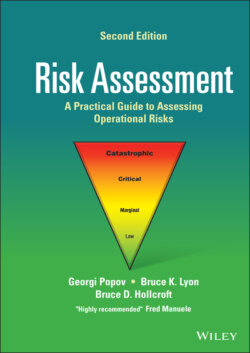Читать книгу Risk Assessment - Georgi Popov - Страница 65
3.11 Risk Evaluation
ОглавлениеRisk evaluation involves comparing the estimated risk levels with the defined risk criteria to determine the significance of the level and type of risk. It is based on the combination of estimated consequences and likelihood and uses information from the hazard/risk identification and risk analysis phases to make recommendations for decision makers. These decisions may include implementing further controls, other forms of risk treatment, or avoiding the hazard or operation all together. Additional inputs to the decision‐making process include legal, financial, ethical, and other considerations. This process may also be used to prioritize possible actions should more than one possible action be feasible.
Methods for defining risk criteria can range from a single‐level dividing risks that require treatment from those that do not, to multiple levels of risk requiring graduated degrees of actions. Decisions on treating a risk will likely depend on the costs and benefits of risk and the costs and benefits of implementing improved controls. The “as low as reasonably practicable” or
ALARP criteria are used to determine when the cost of further reduction is disproportionate to the benefits gained in risk reduction and safety. Figure 3.5 provides an illustration of the ALARP principle.
Figure 3.5 The ALARP model.
The established risk criteria and matrix are used to consider both the consequence and likelihood risk levels for each risk. The risk assessment matrix example provided in Table 3.1 is qualitative in nature with risks ranging from “High” to “Low”. In the example matrix, risks that fall in the “Low” category would most likely be considered acceptable by an organization, while those in the “Medium” category may be considered acceptable with some additional controls. Risks in the “Serious” category would require immediate action, and those in the “High” category are considered the highest risk and would be unacceptable to an organization, requiring immediate action to avoid or reduce the risk to acceptable levels. In each case, the criteria for severity of consequence and likelihood of occurrence will need to be customized and defined by the organization’s stakeholders.
In Fred Manuele’s article “Acceptable Risk; Time for SH&E professionals to adopt the concept” published in Professional Safety, May 2010, he suggests that safety professional have yet to fully embraced the concept of “acceptable risk.” The fact is that there will always be some level of residual risk.
The ultimate goal is to reduce the risk of the hazard or operation to an acceptable level so as to feel confident in engaging in the activity. This may be accomplished though the implementation of additional or better controls according to the Hierarchy of Controls concept mentioned throughout this book, or it may involve other forms of risk treatment. Avoiding the risk by deciding not to engage in the hazard is always an option if the risk of engaging in it cannot be reduced to an acceptable level. A personal example might include a homeowner that decides not to clean their gutters because it is too dangerous or risky to work at heights. Instead, they hire a contractor who has better equipment and is better trained to perform the work. The homeowner decided the risk was not acceptable, so they avoided it by having a contractor perform the work.
It should also be mentioned that risk assessments are a process of continuous improvement. Risks that are estimated to be acceptable today may not be acceptable in the future. For example, as an organization’s operational risk management system matures, new technologies and more effective controls are incorporated through continuous improvement, reducing the organization’s ALOR. The term “acceptable” refers to a point in time and will not likely be true in the future as expectations rise and what is considered acceptable in terms of risk lowers. As the highest risks are treated and reduced, the next highest risks are addressed until all risks are reduced to an ALOR.
